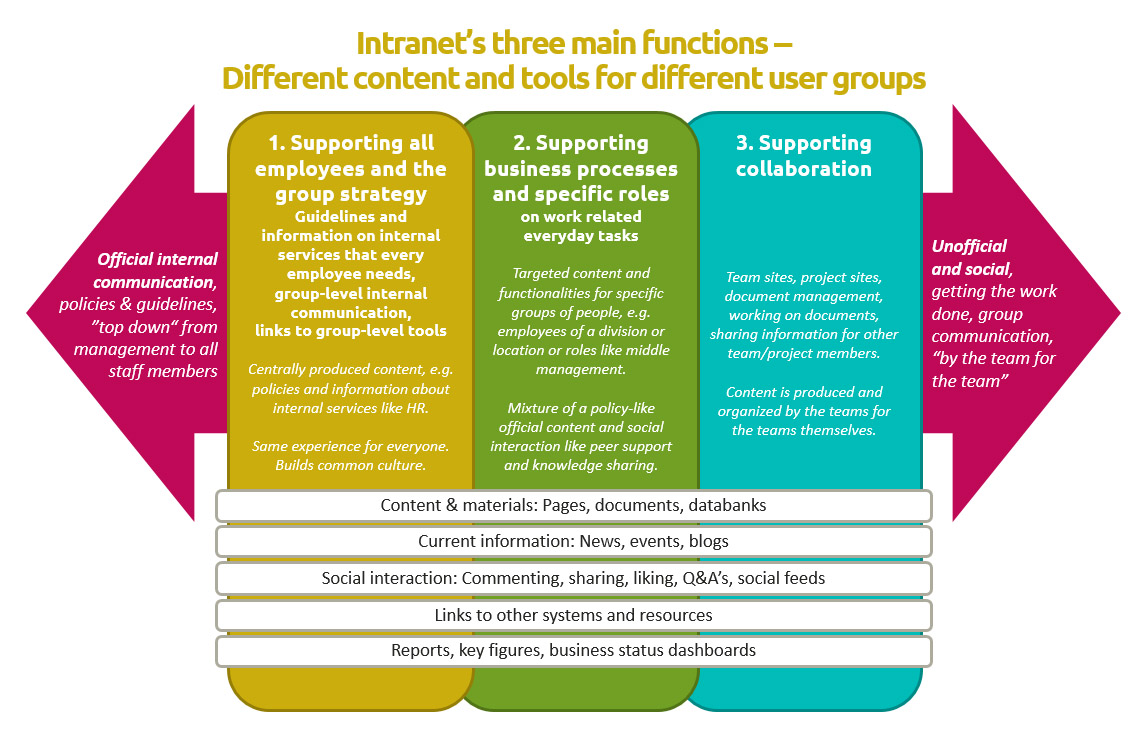Intranet renewals typically involve pondering whether or not workspaces are part of the intranet, and should collaboration in the workspaces be implemented on the same technology platform as the communicational intranet . Yes and no – both are possible.When we look at the intranet from the perspective of its communicational nature and communicational features, its functions within the organization fall into three main categories:
North Patrol is a consulting firm specialized in the design of digital services and information systems. We shape ideas into a vision and service concept, find the best architectural and technological solutions, design a functional user experience, and compete to find the ideal partner for implementation work. We do not sell implementation projects, nor do we sell licenses; we are genuinely on the side of the customer.

- Internal communications and support for organizational culture
- Support for job tasks & processes
- Working
All of these functions are not necessarily present in all intranets. (I suggest, however, that the first function of the intranet is so fundamental that there won’t be an intranet without it.)
From technological perspective, all of the three functions may include the same types of content and features, although with slightly different weighting: documents and pages, news, links, social features and key figures.
1. Internal communications and support for organizational culture
On the intranet, this function manifests itself in practice through guidelines and communication intended for all employees. They include, for example, the organization’s strategy, HR instructions, internal communications, and everyday content for the employees, such as canteen menus. By nature, these are mostly official information approved by the organization’s management typically updated by only a few people but in practice consumed by all employees.
In large and/or complex organizations, the common content may be divided, for example, into different language versions.
2. Support for job tasks & processes
Support for job tasks has a natural connection to the organization’s processes and job roles. If the organization only includes a few people with fairly similar tasks, it is sensible to include these work instructions as part of the common guidelines.
Often, however, this is not the case. Guidelines for work and activities should be categorized according to the nature of the work – all content is not relevant for all employees. The categories should be designed so that both the use and the production of the content is easy and clear.
From the communication point of view, content supporting job tasks is “mixed”, including both official instructions “carved in stone” with a mass communicational nature (such as occupational safety), and communal content created by the personnel involved in the process or role in question (such as Q&A for the maintenance of a paper machine).
3. Working
Working takes place in the form of collaboration in workspaces, sites, or social groups. The work community creates and develops knowledge and information for its own use, as well as categorizes and refines it. Work happens within the communities, and people outside of the communities do not necessarily even understand the content of other groups. Work is conducted based on the communities’ own rules and in a fairly informal fashion.
The nature of the organization defines the intensity of workspace usage and whether the workspaces are implemented on the same platform as the other intranet functions. If the organization almost entirely includes only knowledge workers, it is natural that all three intranet functions are implemented on the same platform.
If the organization includes, for example, many production and field employees (blue-collar), the collaboration does not take the form of complex co-creation of documents within workspaces, but possibly more social media-like participation within communities.
Technology choices according to function emphasis
The three functions of the intranet can be technologically implemented on the same platform or on different platforms.
For example, the fundamental function of internal communications and support for organizational culture can very well be implemented even using CMS systems with a lightweight output that responsively scales to smartphones, because the needs revolve mostly around online publication and news instead of collaboration. The platform might be EPiServer or WordPress.
For actual knowledge work and collaboration, on the other hand, totally different tools are needed, such as Office 365 with SharePoint Online, Confluence, or Google Apps for Work, and/or a supporting group instant messaging tool, such as Yammer, HipChat or Slack.
Supporting job tasks & processes takes very different forms in different organizations; depending on the nature of the organization. If this function is a priority, portal platforms such as Liferay may be considered.
How to ensure the success of the intranet?
To ensure the clarity – or the success! – of the intranet, it is essential to identify and define its contents and functionalities. Which of the previously mentioned functions do they serve? The roles pertaining to the content and the functionalities must be very clear, and the whole organization must understand them in the same way.
The intranet is unique to every organization. The intranet performs internal communication and digital working functions that first of all, are natural to the organization, and second, are sensible to implement through an intranet. This means that the intranet takes different shapes in different organizations.
These three intranet functions described above are typically implemented on one or two platforms. In my opinion, the clear and consistent roles of the services are more important than the technology platforms or how many platforms are used. The roles should be understood and approved by everyone. Consistency results in the reliability of internal digital tools – and their success.
Need assistance in buying an intranet?
At North Patrol, we assist our clients with the competitive bidding process: drawing up documented requests for proposals, describing the requirements for the entity to be procured, setting comparison criteria and handling the comparison of the proposals received. As an independent consulting company without ties to system vendors and technologies, we can assist clients in assessing platform products and implementation companies without bias. We have exceptionally wide-ranging knowledge of implementation partners in Finland and Scandinavia, and can suggest suitable partners for each particular need. Our area of special expertise is handling competitive bidding for public sector projects in Finland.
